Pulpal Response To Restorative Materials Notes
Dental Pulp Introduction
Dental pulp performs formative, nutritive, and defensive functions throughout its life. Th dentine-pulp complex shows a broad spectrum of responses to caries and other operative procedures ranging from the summation of injury to defense, and repair events.
Table of Contents
These responses can occur if the pulp is vital and to preserve the pulp viability and functions, utmost care should be taken to avoid or reduce the potentially injurious effects of tooth preparation, conditioning, and restorative materials.
Read And Learn More: Endodontics Notes
Response Of Pulp To Dental Caries
The pulp gets affected by caries directly or indirectly from the bacteria, acids, and other toxic substances which penetrate through the dentinal tubules. Depending upon the caries progression, pulp shows different types of defense mechanisms.
Pulp Capping
Factors Affecting Carries Progression on Pulp Dentin Complex
- Type of decay: In the case of chronic decay, pulp shows better defense as compared to acute decay.
- Speed of caries progression: Chronic decay leads to repair whereas acute decay causes destruction of pulp.
- The extent of caries: Even with more depth, chronic caries may show repair whereas acute caries cause pulp exposure.
- Tooth resistance factors: Th greater the remaining dentin thickness, the lesser the pulpal damage. The more the permeability and solubility of dentin, the more pulpal damage.
- Individual factors: As age increases, the vascularity of the pulp decreases; this further reduces the repair capability of the pulp.
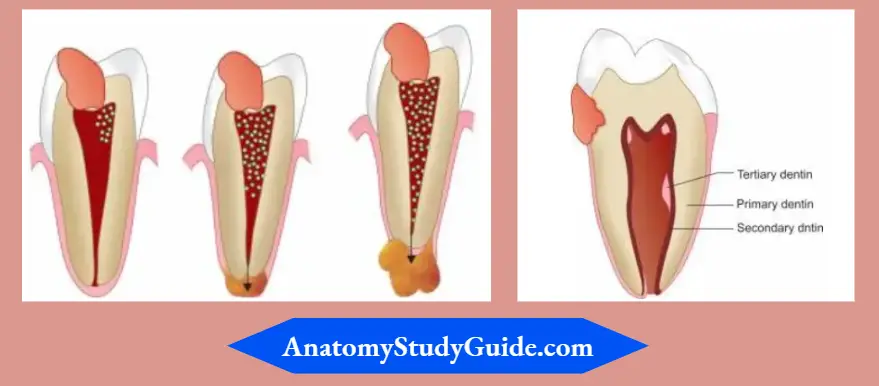
- (A) Small number of bacteria close to pulp;
- (B) As caries progress close to the pulp, inflammation starts with more of plasma cells, macrophages, and lymphocytes;
- (C) Exposure of pulp by caries. The site of exposure shows a small abscess
consisting of dead inflammatory cells and other cells
The following defense reactions takes place in a carious tooth to protect the pulp:
Decrease in Dentin Permeability
- It is the first and the fastest defense to caries in the form of dentin sclerosis.
- In this, there is an increase in the deposition of mineral crystals in dentinal tubules causing the narrowing of the tubules and thus a decrease in the permeability of dentin.
Pulp Capping
Tertiary Dentin Formation
Formation of tertiary dentin occurs after a mild injury (mild-to-moderate carious lesion), in which odontoblasts survive after the stimuli. Here, acidic products of the carious process degrade the dentine matrix and release bioactive molecules which resume their role of dentin formation.
More intense injury leads to odontoblast death which is followed by the formation of reparative dentine. Here, healing takes place by recruitment of stem or progenitor cells from the pulpal origin which differentiate to odontoblast-like cells.
These cells perform the secretory activity and tissue mineralization resulting in reparative dentin formation. rate of reparative dentin formation is related to the rate of carious attack. More reparative dentin is formed in response to slow chronic caries than acute caries.
Inflammatory and Immunological Reactions
Bacterial toxins, enzymes, organic acids, and the products of tissue destruction show an inflammatory response in the pulp. The degree of pulpal inflmmation depends on the remaining dentin thickness (EDT). Pulp underlying reparative dentin remains relatively normal until the carious process comes close to it. Bacteria are seldom seen in the unexposed pulp.
When the pulp is exposed, bacteria penetrate the infected dentinal tubule and cause the beginning of inflmmation of the pulp.
- The early evidence of pulpal reaction to caries is seen in the underlying odontoblastic layer. There is a reduction in the number and size of odontoblast cells bodies, a change in the shape of odontoblasts, that is, from tall and columnar to flt and cuboidal before any inflammatory changes are seen in the pulp
- Concomitant with the changes in the odontoblastic layer, a hyperchromatic line may develop along the pulpal margin of the dentin, which indicates a disturbance in the normal equilibrium of the odontoblasts
- In addition to dentinal changes, antibodies are also produced by the pulp. Immunoglobulins, IgG, IgM, IgA, complement components, etc. found in the odontoblasts and adjacent pulp cells are capable of reacting against invading microorganisms
- The presence of bacterial antigens and immunoglobulins emphasizes the involvement of specific immunologic reactions during the carious process
- The persistence of dental caries provides a continuous stimulus for an inflammatory response in dental pulp
- Pulp reacts at the site of exposure with infiltration of inflammatory cells. In the region of exposure, a small abscess develops consisting of dead inflammatory cells and other cells.
- The remainder of the pulp may be uninflamed or if the exposure is present for a long time, the pulp gets converted into granulation tissue
- Chronic inflammation can be partial or complete, depending upon the extent and amount of pulp tissue involved
- As the exposure progresses, partial necrosis of pulp may be followed by total pulp necrosis
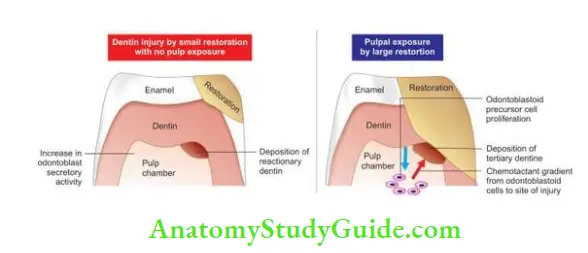
Response of Pulp To Tooth Preparation
Pulpal inflmmation resulting from the operative procedures is often termed entactogenic pulpitis. The pulpal reaction depends on
Pulp Capping
- Degree of pulpal inflmmation before treatment
- Degree of physical, chemical, and biological irritation
- The proximity of restorative procedure to pulp
Degree of Pulpal Inflmmation Before Treatment
In case of symptoms of pulpal exposure, the clinician cannot determine the degree of preoperative inflmmation but if the pulp is healthy, every effort should be made to minimize the irritation to the dental pulp.
Degree of Physical, Chemical and Biological Irritation
Pressure
The pressure of instrumentation causes aspiration of odontoblasts or nerve endings from pulp tissues into the dentinal tubules. This disturbs the metabolism of odontoblasts leading to their complete degeneration and disintegration.
Instrumentation pressure should not be >4 oz when using high speed and 12 oz when using low speed.
Heat Production
If pulp temperature is elevated by 11°F, a destructive reaction will occur even in a normal, vital periodontal organ. “Heat” is a function of
- RPM, that is, the more the rPM greater is the heat production
- Pressure: It is directly proportional to heat generation
- The surface area of contact: Th more the contact between tooth structure and the revolving tool, the greater the heat generation
- Desiccation: It causes aspiration of odontoblasts into tubules. Subsequent disturbances in their metabolism may lead to the complete degeneration of odontoblasts
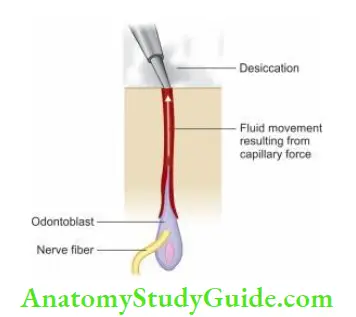
Vibrations
Vibrations are measured by their amplitude or their frequency (the number/unit time). Vibrations are an indication of eccentricity in rotary instruments. The higher the amplitude, the more destructive is the pulp response.
Speed of Rotation
Ultrahigh-speed should be used for the removal of enamel and superficial dentin. A speed of 3,000–30,000 rpm without coolant can cause pulpal damage.
Pulp Capping
Nature of Cutting Instrument
The use of worn of and dull instruments can cause vibration and reduced cutting effiency. This further encourages the clinician to apply excessive operating pressure, which results in increased temperature leading to thermal injury to the pulp.
Use of Coolants
Water spray is considered as the ideal coolant. In deep cavities, cotton pellets instead of air blasts should be used to dry the prepared cavity because air blasts can cause desiccation of dentin which can damage the odontoblasts.
Commonly used coolants are air spray, water jet, air, and water.
The proximity of Restorative Procedure to Pulp
Remaining Dentin Thickness Remaining dentin thickness (rDT) is the dentin present between the floor of the tooth preparation and pulp chamber. This measurement differs from the depth of tooth preparation since the pulpal floor in deeper preparation on larger teeth may be far from the pulp than that in shallow preparation on smaller teeth.
Generally, 2 mm of dentin thickness between the floor of the tooth preparation and the pulp will provide an adequate insulating barrier against irritants. As dentin thickness decreases, the pulpal response increases.
Studies have shown that 0.5 mm of remaining dentin thickness reduces the effect of toxic substances on the pulp by 75% whereas 1.00 mm of thickness of dentin reduces it by 90%.
If the remaining dentin thickness is more than 2 mm or more, a little or no pulpal reaction is seen. This helps us to make the decision regarding the use of liners and bases.
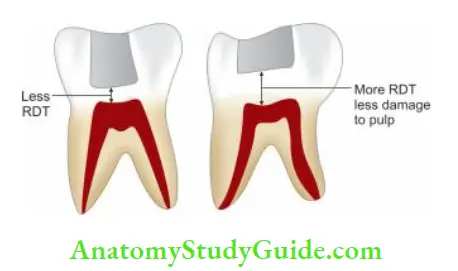
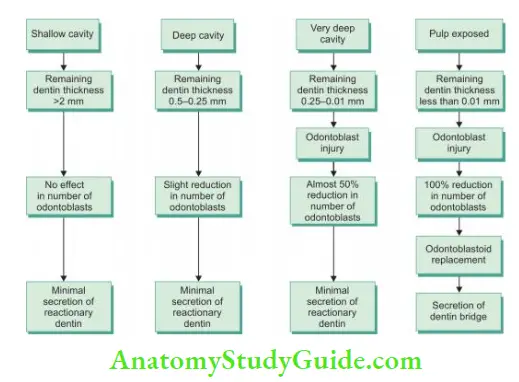
Response Of Pulp To Local Anesthetics
- Vasoconstrictors are added to local anesthesia for prolonging the anesthetic effect by reducing the blood flow in the area where anesthetics is administered. The most commonly used vasoconstrictor is epinephrine
- Epinephrine causes a decrease in pulpal blood flow which is directly related to the concentration of epinephrine
- Low oxygen consumption in the pulp helps the healthy pulp to withstand a period of low blood flow when a vasoconstrictor is administered to a reduction in blood flow during a restorative procedure can cause an increase in the concentration of irritants accumulating within the pulp
- However, prolonged reduction in oxygen transport could interfere with cellular metabolism and alter the response of pulp to injury
- Intrapulpal anesthesia is achieved by injecting the anesthetic solution into the pulpal tissue under pressure.
- Here anesthesia occurs due to the pharmacologic action of anesthetic on the nerve cell membrane and circulatory interference from the mechanical pressure of injection.
- Though pulp can withstand decreased blood flow, when blood flow is completely arrested or decreased for a prolonged time, the accumulation of the vasoactive agents occurs in the extracellular compartment of the pulp which can cause permanent damage to the pulp.
Mechanism Of Action Of Local Anesthetics
Dentin Sterilizing Agents
- Silver nitrate: Silver salts diffuse rapidly through the dentinal tubules and reach the pulp tissue, causing an inflammatory reaction in the pulp
- Phenol: Phenol causes an increase in dentin permeability which may further result in greater pulp damage
- Camphorated para chlorophenol and penicillin: A combination of para chlorophenol and penicillin was found to be an effctive sterilizing agent for deep cavities. But studies have shown that this combination produces pulpal inflmmation.
Response Of Pulp To Restorative Materials
Calcium Hydroxide
Calcium hydroxide has been used in dentistry for past many years. It inhibits bacterial enzymes and activates tissue enzymes like alkaline phosphatase. It is used in pulp capping and pulpotomy procedures. Due to its high pH, it causes inflammation, necrosis, and dystrophic calcifications of the pulp. It causes the formation of dentinal bridges which is due to superficial necrosis, deeply staining zone, area of fibrous tissue, and odontoblast-like cells.
Mechanism Of Action Of Local Anesthetics
Mineral Trioxide Aggregate
It consists of tricalcium aluminate, tricalcium silicate, silicate oxide, and tricalcium oxide. Mineral trioxide aggregate (MTA) promotes the regeneration of original tissues when placed in contact with pulp or periradicular tissues. It is used for pulp capping, pulpotomy, root-end filling, apexification, acetogenesis, and perforation repair.
It causes the release of calcium ions and stimulates cytokine release from bone cells which promotes hard tissue formation.
Zinc Oxide Eugenol
- Of all the filing materials, zinc oxide eugenol (ZOE) has always been considered the safest from a biological aspect.
- The sedative effects are because of the ability of eugenol to block or reduce nerve impulse activity
- Its effects due to direct contact are chronic inflmmation, abscess formation, and liquefaction necrosis
- When used in indirect pulp capping, it acts as a bactericidal agent, causes the palliative effect, and arrests caries progression.
Zinc Phosphate
- Zinc phosphate cement can cause severe pulpal damage because of its irritating properties. Toxicity is more pronounced when the cement is placed in deep cavity preparations so it should not be used without intervening liner of ZOE or calcium hydroxide
- Thick mixes should be used to minimize pulp irritation and marginal leakage.
Mechanism Of Action Of Local Anesthetics
Effects of zinc phosphate on pulp are due to:
- Components of zinc phosphate
- Acidic nature
- The heat produced during setting
- Marginal leakage.
Zinc Polycarboxylate Cement
Zinc polycarboxylate cement contains modified zinc oxide powder and an aqueous solution of polyacrylic acid. It is well tolerated by the pulp, being roughly equivalent to ZOE cement in this respect.
Glass Ionomer Cement
- It possesses anti-cariogenic properties and is well tolerated by the pulp
- Toxicity diminishes with setting time. Its pH at mixing is 2.33 and after 24 hours, it is 5.67.
Amalgam
Amalgam is considered one of the safest filling materials with the least irritating properties.
Effects of Amalgam on Pulp
- Mild-to-moderate inflmmation in deep caries
- Harmful effects due to corrosion products
- Inhibition of reparative dentin formation due to damage to odontoblasts
- Copper in high-copper alloy is toxic
- High mercury content exerts cytotoxic effects on pulp
- Postoperative thermal sensitivity due to high thermal conductivity
Postoperative sensitivity of amalgam occurs because of the expansion and contraction of fluid present in the gap between amalgam and the cavity wall. This fluid communicates with fluid in the subjacent dentinal tubule.
Any variation in temperature will cause axial movement of fluid in the tubules which further stimulates the nerve fiers, thus causing pain.
Mechanism Of Action Of Local Anesthetics
Precautions to be taken while using amalgam as a restorative material
- Use of cavity liner or base under amalgam restoration
- Use of varnish restoration at the margins

Restorative Resins
- restorative resins have been used in dentistry for past many years. Despite of having several advantages, they are not considered the best materials because of their high coefficient of thermal expansion and polymerization shrinkage, which results in marginal leakage, subsequently recurrent caries and pulp damage
- Monomer present in composite resins acts as an irritant to the pulp
- The use of cavity-liner-like calcium hydroxide is advocated under composite restoration to protect the pulp
Acid Etchants
Acid etching is done with 37% phosphoric acid. By etching, mineralized peritubular dentin is dissolved causing exposure of collagen fibrils into which resin monomer infiltrates.
If preparation is too dry, collagen fibrils collapse, so it is always recommended to hydrate the dentin prior to bonding so as to keep collagen fibrils patent.
Mechanism Of Action Of Local Anesthetics
Effects Of Pin Insertion
Pins are used in amalgam restoration for building up badly broken teeth or to support amalgam restoration. Pin insertion results:
- Dentinal fractures and unnoticed pulp exposure
- Increases the pulp irritation of already stressed pulp (inflmmation of pulp directly proportioned to depth, the extensiveness of decay)
- Cements used for pins, add more irritation to the pulp.
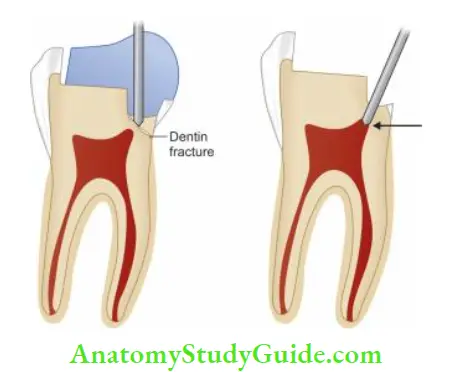
Impression Material
- Impression taking for inlay and crown fabrication exposes the pulp to serious hazards
- Seltzer et al. showed that pulpal trauma can occur when more pressure is applied while taking an impression
- When the modeling compound is applied to the cavity or full crown preparation, pressure is exerted on the pulp. Also, a negative pressure is created while removing an impression, which may cause odontoblastic aspiration.
Dental Impression Procedure
Effects Of Radiations On Pulp
- The basic cellular effect of ionizing radiation is interference with cell division radiation damage to teeth depends on the dose, source, type of radiation, exposure factors, and stage of tooth development at the time of irradiation
- In developing human teeth, the extent of damage depends on the amount of radiation and the stage of tooth development. Heavy doses at the earliest stage of development can cause complete failure of the tooth to develop; mild doses can result in root-end distortions and dilacerations.
- Circulatory disturbances in the tooth germ are also manifested by the presence of dilated vessels, hemorrhages, and endothelial cell swelling
- Odontoblasts fail to function normally and may elaborate abnormal dentin and amelogenesis is retarded or ceases. In later stages, fibrosis or atrophy of the pulp may occur
- Pulps of fully formed human teeth also get affected in irradiated teeth. Though mature odontoblasts appear to be extremely radioresistant, pulp cells exposed to ionizing radiation may become necrotic. The effects appear to be related to vascular damage and interference with the mitosis of cells.
Dental Impression Procedure
Effect Of Heat From Electrosurgery
- Heat may be delivered to the pulp by electrosurgical gingivoplasty
- Contact of an activated electrode with gingival restorations to no more than 0.2–0.4 s is compatible with clinical usage. However, longer periods of exposure to the electrosurgical currents produced severe pulpal damage
Effect Of Lasers On Pulp
- Commonly used lasers in operative dentistry are Nd: YAG and CO2 laser. Larger doses of laser can cause damage to the pulp. Pulp damage can be manifested by coagulation necrosis of the odontoblast, edema, and inflammatory cell infiltration
- The mode of action in hypersensitivity teeth is by altering the dentin surface, blocking dentinal tubules, and by melting and glazing dentin. It may be also due to the transient anesthesia due to permanent damage to sensory nerves
Defense Mechanism Of Pulp
1. Tubular Sclerosis
Peritubular dentin becomes wider gradually filling the tubules with calcified material progressing with the dentin enamel junction palpably. These areas are harder, denser, less sensitive, and more protective to the pulp against subsequent irritation.
Sclerosis resulting from aging is physiological dentin sclerosis and resulting from mild irritation is reactive dentin sclerosis.
2. Smear Layer
The smear layer is an amorphous debris layer consisting of both organic and inorganic constituents caused iatrogenically during operative procedures. It decreases both the sensitivity and permeability of dentinal tubules.
3. Reparative Dentin Formation
- Healthy Reparative Reaction
This is the most favorable response and it consists of stimulating the periodontal organ to form sclerotic dentin. These are followed by normal secondary dentin-containing dentinal tubules. Secondary dentin is different from primary dentin, in that the tubules of secondary dentin slightly deviate from the tubules of the primary dentin.
- Unhealthy Reparative Reaction
This response begins with the degeneration of odontoblasts, followed by the formation of the dead tract in the dentin and complete cessation in the formation of secondary dentin.
Pulpal Considerations For Operative Dentistry
An unhealthy reparative response is accompanied by mild pathological and clinical changes of a reversible nature in the pulp tissues, resulting in the formation of an irregular type of tertiary dentin.
The tertiary dentin formation is considered to be the function of the pulp tissue proper. However, tertiary dentin has certain limitations. It is not completely impervious like the calcified barrier.
Also, the rapid formation of tertiary dentin can occupy part of a pulp chamber with tissues other than those normally responsible for repair, metabolism, and innervations. This tertiary dentin is said to “age the pulp,” reducing its capacity for further defensive action against irritation.
This is very important clinically, because if this reaction occurs as a result of a carious process, the restoration of this tooth may not be favorably, received by the periodontal organ.
- Destructive Reaction
This is the most unfavorable pulpal response to irritation. It begins with the loss of odontoblasts and the outer protective layer of the pulp which ultimately involves the pulp tissue properly exceeding its reparative capacity.
The resulting tissue reaction will be inflmmation, which may progress to abscess formation, chronic inflammation, and finally, complete necrosis of the pulp. In any event, the pulp tissues cannot recover from these pathologic changes and removal of these tissues or the whole tooth becomes necessary.
Pulpal Considerations For Operative Dentistry
The defense mechanism of the pulp
- Tubular sclerosis
- Smear layer
- Reparative dentin formation:
- Healthy reparative reaction
- Unhealthy reparative reaction
- Destructive reaction
Prevention Of Pulpal Damage Due To Operative Procedure
To preserve the integrity of the pulp, the following measures should be taken:

How Does Pulp Recover
As tissue pressure increases from increased blood flow, arteriovenous anastomoses (AVAs) open and shunt blood before it reaches an inflamed region, thus preventing a further increase in blood flow and tissue pressure
An increase in tissue pressure pushes macromolecules back into bloodstream via venules in the adjacent healthy pulp
Once macromolecules and excess fluid leave the extracellular tissue space via venule, tissue pressure decreases and normal blood flow is restored
Leave a Reply